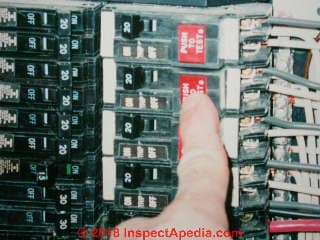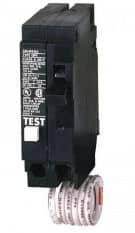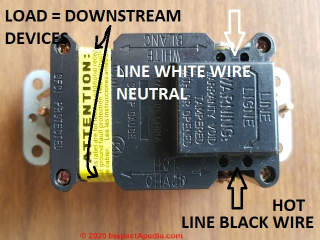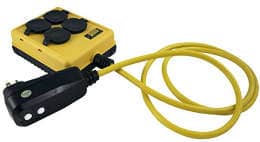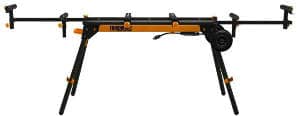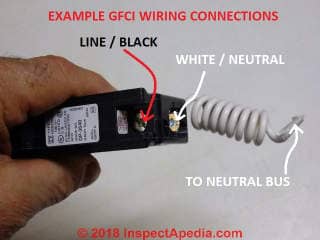 GFCI Installallation Options & Wiring
GFCI Installallation Options & Wiring
Ground Fault Circuit Interruptor Wiring Details
- POST a QUESTION or COMMENT about ground fault circuit interrupters
Ground Fault Circuit Interrupters, GFCI Device Choices & Wiring Details
How to choose a GFCI device and how to install GFCI circuit breakers, receptacles, or portable, stand-alone GFCI protection devices.
This article series GFCI and AFCI protection for buildings.
InspectAPedia tolerates no conflicts of interest. We have no relationship with advertisers, products, or services discussed at this website.
GFCI Options, Installation & Wiring Instructions
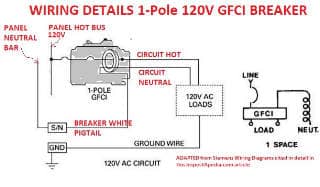 As we introduce also if certain high-risk electrical circuits in your home or building is not already protected by GFCI devices in the electrical panel or at the appropriate electrical receptacles ("wall plugs"), we recommend that you have that protection added.
As we introduce also if certain high-risk electrical circuits in your home or building is not already protected by GFCI devices in the electrical panel or at the appropriate electrical receptacles ("wall plugs"), we recommend that you have that protection added.
The high shock risk areas for which GFCIs add significant safety protection are damp or wet locations or locations where a person is likley to be handling an electrical device and be close to a sink, tub, shower or other plumbing or water equipment.
The GFCI detects a tiny (about 4 to 5 milliamps) flow of electrical current between the electrical circuit or something plugged-in to a GFCI-protected electrical receptacle) and the circuit "ground" or the earth.
On detection of this current flow the GFCI quickly trips (in about a tenth of a second) to turn off the electrical circuit to reduce the chances of a dangerous or even fatal shock.
Typical GFCI-protected locations include bathrooms, garages, kitchens, at outdoor electrical circuits and of course near swimmng pools. That's not the whole list. At GFCI PROTECTION, GFCI CODES we provide a full list of the locations where electrical codes require this protection in new or renovation construction.
Watch out: never plug any life-saving devices into a GFCI electrical receptacle that will lose power during testing. Every receptacle that will lose power when a GFCI trips should be labelled GFCI-Protected.
We also caution against plugging a refrigerator or freezer or other critical cold-storage equipment into a GFCI-protected receptacle (for example downstream from the actual GFCI devicve) as any condition that trips the GFCI can leave the cold storage equipment off without notice.
Some electrical circuits that need to be assured of continuous operation include medical equipment, refrigerators, freezers, and sump pumps.
See also FREEZE-PROOF A BUILDING where we describe GFCI protection on heat tape circuits powering heat tapes for manufactured and mobile homes.
Similar issues regarding building water entry control are discussed
Four Ways to Add GFCI Protection
- GFCI circuit breaker: Install a GFCI circuit breaker in the electrical panel, replacing the original breaker, to protect an entire circuit, such as a kitchen, garage, or outdoor receptacle circuit
Below is a Siemens 120V single pole ground fault circuit interruptor circuit breaker or GFCI breaker. The company provides a range of GFCI breakers including 1-pole and 2-poles, from 15A to 60A in size.
The company's data sheet for this GFCI breaker series notes that while a load neutral wire is not required on the circuit, the coiled white pigtail wire from the breaker must be connected to the neutral bus in the electrical panel for the GFCI to work.
Other brands and models of GFCI circuit breakers require that
- the hot load (circuit hot or black wire)
- load neutral (circuit neutral wire) be connected to the GFCI breaker
- the third or pigtail wire that is permanently connected to the GFCI breaker is connected to the panel neutral bus.
Watch out: before buying a GFCI circuit breaker be sure that the breaker is the proper one for the brand and model of electrical panel into which it is to be installed.
OK so what are the exact steps in wiring up or installing a GFCI device?
At CIRCUIT BREAKER REPLACEMENT we describe in further detail the steps followed to replace an existing circuit breaker with a GFCI-type (or AFCI-type) circuit breaker in an electrical panel.
GFCI Add-on Space Limitations in Some Electrical Panels
Standard circuit breaker widths, using Siemens as an example are 1" for a 120V breaker and 2" for a 240V breaker. In some electrical panels, such as our electrical panel photo shown just above on this page, you may find both full-width and half-width breakers already installed.
If the electrical panel is full or quite crowded you may find that you need to replace several normal-width circuit breakers with narrow half-width circuit breakers - a procedure called "skinnying-up" in the panel - in order to make room for a full-width GFCI breaker.
Watch out: if you have to change some circuit breakers from full to half-width or "skinny" circuit breakers AND if there are multi-wire shared-neutral circuits originating in the electrical panel, you will need to take care in locating those circuit breaker pairs to assure that each breaker is on a different panel bus connector and phase.
Details are at MULTI-WIRE CIRCUITS
- GFCI wall receptacle: Install a GFCI electrical receptacle to replace an existing electrical receptacle in a high-risk location such as a bathroom or kitchen etc.
The GFCI receptacle will protect any device plugged in to that receptacle and it will protect all of the electrical receptacles (and devices plugged into them) that are wired "downstream" from the receptacle where the GFCI is placed.
In some buildings bathroom receptacles are wired in series between two or more baths and a GFCI is placed in the first receptacle in that string.
- Portable GFCI devices: Use a plug-in or portable GFCI protection device that is connected to a wall receptacle.
Often a portable GFCI device is simply a short extension cord that includes at one end its own GFCI protection. Devices that are then plugged into the GFCI-protection device are themselves protected, as are their users.
We often use a portable GFCI protector in construction projects to run our power tools because we don't count on every building or home where we work to have properly-installed GFCI protection.
Shown above: a Yellowjacket-brand portable GFCI protected extension cord.
- GFCI-protected tools, devices, appliances: some devices may include their own built-in GFCI device. Shown below: Toughbuilt TB-S560 universal miter saw stand with its own built-in GFCI protection, sold at Home Depot stores and by other suppliers.
GFCI Installation Guides & Device Specifications
- CIRCUIT BREAKER REPLACEMENT - web article
- Eaton, INSTALLING & TESTING a GFCI RECEPTCLE [PDF], Eaton, Website: www.eaton.com or www.cooperwiringdevices.com retrieved 2018/07.27,original source: http://www.cooperindustries.com/content/dam/public/wiringdevices/products/documents/instruction_sheets/EIS-0018-E.pdf
- Hubbell, INSTALLING & TESTING a GFCI RECEPTACLE [PDF] , Hubbel Corporation, 40 Waterview Dr., Shelton CT 06484 USA, Website: retrieved 2018/07/27, original source: http://www.arrl.org/files/file/Technology/GroundingAndBonding/Installing%20and%20Testing%20a%20GFCI%20Receptacle.pdf
- Larson Electronics, Tel: 1-877-432-0861 / International: 1-903-498-3363 Email: sales@larsonelectronics.com, Website: larsonelectronics.com Larson provides GFCI protected linecords and other electrical equipment.
- Legrand, INSTALLING and TESTING a GFCI RECEPTACLE [PDF] Pass & Semour Legrand, PO Box 4822, Syracuse NY 13221 USA, Tel: 800-223-4185, Website: www.legrand.us, retrieved 2018/07/27, original source:
- Leviton, GFCI INSTALLATION & TEST PROCEDURES [PDF], retrieved 2018/07/27, original source: https://www.leviton.com/en/docs/guidelight.pdf
- Siemens GFCI CIRCUIT BREAKER DATA SHEET & WIRING DIAGRAMS [PDF] retrieved 2018/09/07, original source: siemens.com/gfci
- Siemens CIRCUIT BREAKER & GROUND FAULT CIRCUIT INTERRUPTER Specifications Sheet [PDF] retrieved 2018/09/07, original source: https://gfiwarehouse.com/~gfiwareh/siemensdatasheet.pdf
- GFCI WORKPLACE TEST REQUIREMENTS OSHA [PDF] U.S. OSHA, - retrieved 2018/07.27, original source: www.osha.gov/laws-regs/standardinterpretations/1992-02-10
- U.S. CPSC, What is a GFCI, [PDF] U.S. Consumer Product Safety Commission, retrieved 2018/07.27, original source: https://www.cpsc.gov/s3fs-public/099_0.pdf
Reader Comments, Questions & Answers About The Article Above
Below you will find questions and answers previously posted on this page at its page bottom reader comment box.
Reader Q&A - also see RECOMMENDED ARTICLES & FAQs
On 2020-12-04 by (mod) - use pigtailing to avoid nuisance tripping at GFCIs
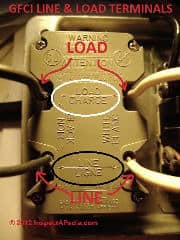 Brian
Brian
Indeed some electricians have recommended the pigtailing trick to wire the GFCI as a means to stop nuisance tripping. Electrically it means that the current to the other device on the circuit (the fan) is not passing through the GFCI device.
I'm not 100% confident that pigtailing works in every wiring situation but certainly you've shown that it can in the one you describe.
Your note will certainly help other readers.
Thank you.
On 2020-12-04 by Brian
The GFCI has two holes for each terminal into which wires can be inserted (2 line +, 2 line -, 2 load +, 2 load -).
I had the supply cable from the basement attached to one set of line holes and the fan attached to the other set.
So I guess yes, they share a neutral to the extent that the neutral from the fan is directly connected to the same terminal that the GFCI is using to connect to the main circuit neutral. Yesterday I pigtailed the GFCI (the ground was already pigtailed) and that stopped the tripping!
So they are both still ultimately connecting to the same neutral cable going to the basement in the box but the fan is not connected to the GFCI directly. Thank you for your help!
On 2020-12-04 by (mod) - common causes of GFCI Nuisance Tripping or Ghost Tripping
Brian
Can you determine whether or not the kitchen vent van and GFCI receptacle are using the same neutral wire? A shared neutral will indeed cause nuisance tripping on a GFCI device.
Other causes of nuisance tripping of GFCI's and AFCIs
(other than a shared neutral wire)
Other sources of GFCI nuisance tripping have been described by some electrical engineers and other sources as including
- Too many devices on the GFCI circuit (cumulative very small leakages may be enough to trip the device)
- very long wiring runs of a GFCI circuit
- surge suppressors or large capacitors in devices on the circuit
- See also
NUISANCE TRIPPING of AFCIs
Fluke, a maker of electrical test equipment has a helpful discussion of GFCI nuisance tripping at
- "Chasing "ghost" trips in GFCI-Protected Circuits" - Fluke, Technical Support: how to operate Fluke products: Email: tech.support@fluke.com Te;" 800-87-FLUKE (800-873-5853) - original source: https://www.fluke.com/en-us/learn/blog/grounding/chasing-ghost-trips-in-gfci-protected-circuits
This article makes an important point: when a GFCI is tripping do not assume that it's a harmless "nuisance trip" - as in fact the GFCI may be doing its job and keeping you from getting zapped.
Unfortunately few homeowners have the training nor equipment (a clamp-type current leakage monitoring instrument) to actually measure the leakage at the GFCI.
On 2020-12-01 by Brian - kitchen fan trips GFCI
GFCI receptacle in kitchen with vent fan on wall above. Feed runs from basement to line terminals on GFCI.
Fan, also on line side, causes GFCI to trip when turned on. Not clear why this happens when all is on line side -- thought GFCI shouldn't react to things on line side?
Fan is old mode with old switch that is likely basically 2 bits of metal with fan vent door opening action causing them to get closer and closer. At some stage the gap is small enough for a spark to jump before being fully in contact and this trips the GFCI.
I don't think the switch is bad, just primitive. Plugging the fan into an outlet on the GFCI doesn't cause it to trip, it's the switch being turned on is the problem.
I was wondering if instead of sharing line terminals on the GFCI itself if I instead put the GFCI on a pigtail would that be enough to isolate it from the fan branch?
...
Continue reading at GFCI TEST PROCEDURES or select a topic from the closely-related articles below, or see the complete ARTICLE INDEX.
Or see these
Recommended Articles
- AFCIs ARC FAULT CIRCUIT INTERRUPTERS
- CIRCUIT BREAKER REPLACEMENT - how to replace a circuit breaker
- ELECTRICAL OUTLET, HOW TO ADD & WIRE
- ELECTRICAL SPLICES, HOW TO MAKE
- GFCI PROTECTION, GFCI CODES
- ELECTRICAL RECEPTACLE TYPES
- MULTI-WIRE CIRCUITS
- NUISANCE TRIPPING of AFCIs
- SAFETY for ELECTRICAL INSPECTORS - home
- TEST EQUIPMENT, ELECTRICAL GUIDE
Suggested citation for this web page
GFCI DEVICE SELECTION & WIRING at InspectApedia.com - online encyclopedia of building & environmental inspection, testing, diagnosis, repair, & problem prevention advice.
Or see this
INDEX to RELATED ARTICLES: ARTICLE INDEX to ELECTRICAL INSPECTION & TESTING
Or use the SEARCH BOX found below to Ask a Question or Search InspectApedia
Ask a Question or Search InspectApedia
Try the search box just below, or if you prefer, post a question or comment in the Comments box below and we will respond promptly.
Search the InspectApedia website
Note: appearance of your Comment below may be delayed: if your comment contains an image, photograph, web link, or text that looks to the software as if it might be a web link, your posting will appear after it has been approved by a moderator. Apologies for the delay.
Only one image can be added per comment but you can post as many comments, and therefore images, as you like.
You will not receive a notification when a response to your question has been posted.
Please bookmark this page to make it easy for you to check back for our response.
Our Comment Box is provided by Countable Web Productions countable.ca
Citations & References
In addition to any citations in the article above, a full list is available on request.
- UL 943, Ground-Fault Circuit Interrupters, retrieved 2016/08/08, original source: http://ulstandards.ul.com/standard/?id=943
Excerpt:
1.1 This Standard applies to Class A, single- and three-phase, ground-fault circuit-interrupters intended for protection of personnel, for use only in grounded neutral systems in accordance with the National Electrical Code (NEC), ANSI/NFPA 70, the Canadian Electrical Code, C22.1 (CEC), and Electrical Installations (Use), NOM-001-SEDE. These devices are intended for use on alternating current (AC) circuits of 120 V, 208Y/120 V, 120/240 V, 127 V, or 220Y/127 V, 60 Hz circuits. Note: In Canada, the text "intended for protection of personnel" is excluded. - NEMA, "Understanding GFCIs, Developed by the NEMA 5PP Personnel Protection Technical Committee" [Power Point Presentation], (2012)retrieved 2016/08/08, original source: https://www.nema.org/Products/Documents/NEMA-GFCI-2012-Field-Representative-Presentation.pdf
- Antman, Steve, Roger Nolter, and Danny Liggett. "New rules for ground fault circuit interrupters." In 2011 IEEE IAS Electrical Safety Workshop, pp. 1-4. IEEE, 2011.
- El-Sherif, Nehad, Rick Mendler, John Trotte, and Ajay Pathak. "Ground fault protection of personnel in industrial locations using the new UL 943C." In 2014 IEEE Petroleum and Chemical Industry Technical Conference (PCIC), pp. 409-414. IEEE, 2014, retrieved 2016/08/08, original source: http://www.csemag.com/single-article/ul-s-new-gfci-classes/89c8746cdc4a7fd8a3cb93f1d51ba57a.html
- LaRocca, Robert L. "Personnel Protection devices for use on appliances." IEEE transactions on industry applications 28, no. 1 (1992): 233-238.
- Neitzel, Dennis K., and Timothy L. Gauthier. "Ground fault protection-GFCI or GFPE-there is a difference." In Electrical Safety Workshop (ESW), 2013 IEEE IAS, pp. 207-210. IEEE, 2013.
- Smoot, Arnold W. "GFCI---Applications and Alternatives." IEEE Transactions on Industry Applications 1 (1975): 56-61.
- Wills, John H., Jan Ehrenwerth, and Dan Rogers. "Electrical injury to a nurse due to conductive fluid in an operating room designated as a dry location." Anesthesia & Analgesia 110, no. 6 (2010): 1647-1649.
- Electrical shock injury statistics: www.healthatoz.com - September 2008;
High-tension current generally causes the most serious injuries, although fatal electrocutions may occur with household current (e.g., 110 V in the United States and Canada and 220 V in Europe, Australia, and Asia). Contact with alternating current at 60 cycles per second (the frequency used in most US household and commercial sources of electricity) may cause tetanic skeletal muscle contractions, preventing self-release from the source of the electricity and thereby leading to prolonged exposure. The repetitive frequency of alternating current also increases the likelihood of current flow through the heart during the relative refractory period (the "vulnerable period") of the cardiac cycle. This exposure can precipitate ventricular fibrillation (VF), which is analogous to the R-on-T phenomenon.-- circ.ahajournals.org - September 2008
- Mark Cramer Inspection Services Mark Cramer, Tampa Florida, Mr. Cramer is a past president of ASHI, the American Society of Home Inspectors and is a Florida home inspector and home inspection educator. Mr. Cramer serves on the ASHI Home Inspection Standards. Contact Mark Cramer at: 727-595-4211 mark@BestTampaInspector.com
- John Cranor [Website: /www.house-whisperer.com ] is an ASHI member and a home inspector (The House Whisperer) is located in Glen Allen, VA 23060. He is also a contributor to InspectApedia.com in several technical areas such as plumbing and appliances (dryer vents). Contact Mr. Cranor at 804-873-8534 or by Email: johncranor@verizon.net
- "Frequency of Occurrence and Sources of Rust and Corrosion in Electrical Panels," Daniel Friedman, IEEE HOLM Conference, Philadelphia PA, 1992 - see ELECTRIC PANEL RUST for an online version of this article.
- Jim Simmons: Personal communication, J. Simmons to Daniel Friedman, 9/19/2008. Photographs contributed to this website by Jim P. Simmons, Licensed Electrician, 360-705-4225 Mr. Electric, Licensed Master Electrician, Olympia, Washington Contact Jim P. Simmons, Licensed Master Electrician, Mr. Electric, 1320 Dayton Street SE
Olympia, WA 98501, Ph 360-705-4225, Fx 360-705-0130 mrelectricwa@gmail.com - Kenneth Kruger: Original author of the sidebar on testing VOM DMM condition: Kenneth Kruger, R.A., P.E. AIA ASCE, is an ASHI Member and ASHI Director in Cambridge, MA. He provided basis for this article penned by DJ Friedman.
- "How to Use DMM's Safely," Leonard Ogden, CEE News, 888 Seventh Ave., New York, NY 10106, Dec 1990 p.10.
- Dr. Jess Aronstein, consulting engineer, Poughkeepsie NY, 1991 protune@aol.com
- Rex Cauldwell, master electrician and contributor to the Journal of Light ConstructionOn electrical topics
- New York State Central Hudson Gas and Electric Company, G&E/1-2/85 consumer safety pamphlet
- American Society of Home Inspectors, ASHI Training Manual, Al Alk -[obsolete, and includes unsafe practices-DF]
- "Electrical System Inspection Basics," Richard C. Wolcott, ASHI 8th Annual Education Conference, Boston 1985.
- "Simplified Electrical Wiring," Sears, Roebuck and Co., 15705 (F5428) Rev. 4-77 1977 [Lots of sketches of older-type service panels.]
- "How to plan and install electric wiring for homes, farms, garages, shops," Montgomery Ward Co., 83-850.
- "Simplified Electrical Wiring," Sears, Roebuck and Co., 15705 (F5428) Rev. 4-77 1977 [Lots of sketches of older-type service panels.]
- "Home Wiring Inspection," Roswell W. Ard, Rodale's New Shelter, July/August, 1985 p. 35-40.
- "Evaluating Wiring in Older Minnesota Homes," Agricultural Extension Service, University of Minnesota, St. Paul, Minnesota 55108.
- "Electrical Systems," A Training Manual for Home Inspectors, Alfred L. Alk, American Society of Home Inspectors (ASHI), 1987, available from ASHI. [DF NOTE: I do NOT recommend this obsolete publication, though it was cited in the original Journal article as it contains unsafe inaccuracies]
- "Basic Housing Inspection," US DHEW, S352.75 U48, p.144, out of print, but is available in most state libraries.
- In addition to citations & references found in this article, see the research citations given at the end of the related articles found at our suggested
CONTINUE READING or RECOMMENDED ARTICLES.
- Carson, Dunlop & Associates Ltd., 120 Carlton Street Suite 407, Toronto ON M5A 4K2. Tel: (416) 964-9415 1-800-268-7070 Email: info@carsondunlop.com. Alan Carson is a past president of ASHI, the American Society of Home Inspectors.
Thanks to Alan Carson and Bob Dunlop, for permission for InspectAPedia to use text excerpts from The HOME REFERENCE BOOK - the Encyclopedia of Homes and to use illustrations from The ILLUSTRATED HOME .
Carson Dunlop Associates provides extensive home inspection education and report writing material. In gratitude we provide links to tsome Carson Dunlop Associates products and services.


